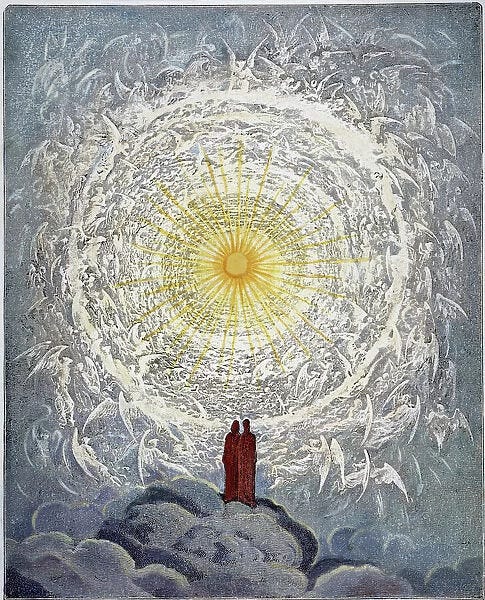In final cantos of the Divine Comedy, Dante surveys, petal by petal, the white, heavenly rose in which the saints are arranged in a spiral hierarchy. The sight for the poet is tremendous but not overwhelming: “My vision in the vastness and the height / Lost not itself, but comprehended all / The quantity and quality of that gladness” (Paradiso, 30). St. Bernard leads Dante in this final ring of paradise, showing him the place each of the saints takes up in the heavenly rose. The saints all enjoy the beatific vision, the blessed, eternal sight of “the love that moves the sun and the other stars” (Paradiso, 33). Yet there is one saint whose sight is not set upon God; rather, she looks at Mary. This is her Mary’s mother, St. Anne. Bernard explains: “Opposite Peter seest thou Anna seated, / So well content to look upon her daughter, / Her eyes she moves not while she sings Hosanna” (Paradiso, 31).
Why does Anne, and why ought we, look upon her daughter, the Blessed Virgin Mary? For Anne, we might say that a mother can recognize and appreciate better than anyone the transformation her child undergoes to become what they were destined to be. Anne looks at Mary because she can see what Christ, Mary’s Son, has done in her. How from the first moment of her Conception, through her glorious Assumption, and to her Coronation as Queen of heaven and earth, the grace of Christ has been with, preserved, and sanctified Mary’s being to the brim. Anne can look at Mary instead of God, because when Anne sees her daughter, she sees God fully alive in her. Anne sees, as Paul once said, God all in all.
For our part, we children still of this earth, look upon Mary not as daughter but as Mother. In the Blessed Mother, we see what it means to be blessed by God beyond compare. Children learn from their mothers first by quiet observation and imitation, then through her instruction and formal teaching. A mother’s teaching is never really finished but continues for as long as she lives and for as long as her children are there to learn from her. Christians learn from the Blessed Mother in the same fashion: observing, imitating, and receiving the way she believes, hopes, and loves. We ask for her prayers every day, “now and at the hour of our death,” that the life of her Son, which lives so vibrantly in her, may live more fully in us.
Today’s feast celebrates a conception, the beginning of new life made perfect by God’s initiative, Mary conceived immaculately, without sin, in her mother’s womb. For us, who are not perfect, yet strive to the same heavenly glory the saints enjoy, we often feel that there is more death and decay in us than life. Our sin, which weighs on us constantly, draws us down, not up. But today’s feast reminds us that sin never has the last word. It demonstrates that it is entirely within God’s power to cast sin out. If God can create a soul without sin, cannot he redeem a soul from its sin? Which is a more impressive show of power: to reconstruct a building that has toppled, or to construct a building that can never be destroyed? Mary received a unique and privileged grace, to be saved from the very beginning, and if God can do that, can he not save us who so often go astray?
God’s initiative made new life within St. Anne. God’s initiative wants to make new life within each of us. The Church’s sacraments are the exact place where God’s life reaches us, enters into our souls, and raises us up from death and decay.
If on December 8 we celebrate the conception of Mary, let every other day — at the very least every Sunday — be when you celebrate a new conception of God’s life within you. Christ living in Mary reveals that Christ can live in you. As Anne looks upon her daughter for eternity, her daughter looks upon us, as a Mother watching over her children, tracking our growth, protecting us from harm, leading us home.
And her help is ever with us, till we take our place in the heavenly rose, gazing in praise upon “the love that moves the sun and the other stars,” and which makes sinners into saints.
Homily preached December 8, 2023 at the Cathedral of Mary Our Queen




